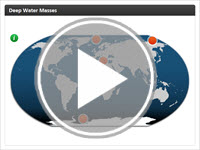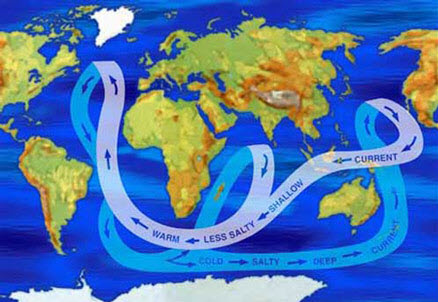
Deep Ocean Circulation
Unlike the surface currents, deep ocean currents are not powered by wind at all. Deep water movement is fueled by differences in density. Density differences in the ocean are primarily caused by two major factors: temperature and salinity. Ninety percent of the water lies below the surface, and there are forces that move this water.
 Thermohaline circulation
Thermohaline circulation
Oceans contain salt, and the ocean has different temperatures of water. Did you know, however, that both these things cause the ocean water to move? Thermohaline circulation is water motion caused by differing water densities. Just like warm air rises, cools, and sinks, the ocean water becomes cold, or salty, and sinks down. If cold water is sinking in one place, it has to be rising in another. When this cold, salty water sinks, it is replaced with an upward flow. This movement is called thermohaline circulation.
Cold, salty water does not just sink to the bottom. The ocean is layered based on density. This is called density stratification. Some water is so dense it sinks to the bottom, some is deep, some is intermediate, some stays at the surface. Refer to the list above to see the five major categories of water masses.
![]() View the video, Thermohaline Circulation, from the NASA/Goddard Space Flight Center Scientific Visualization Studio to see thermohaline circulation in action in the North Atlantic Ocean around Greenland, Iceland, and the North Sea. As you watch the video, remember that thermohaline circulation is responsible for bringing the warm water from the South Atlantic to the North Atlantic that keeps the areas around Iceland and southern Greenland predominately free from ice. The lighter shades of blue represent lower-density surface water, while the darker shades of blue represent the most-dense surface water. The Blue Marble Next Generation data is courtesy of Reto Stockli (NASA/GSFC) and NASA's Earth Observatory.
View the video, Thermohaline Circulation, from the NASA/Goddard Space Flight Center Scientific Visualization Studio to see thermohaline circulation in action in the North Atlantic Ocean around Greenland, Iceland, and the North Sea. As you watch the video, remember that thermohaline circulation is responsible for bringing the warm water from the South Atlantic to the North Atlantic that keeps the areas around Iceland and southern Greenland predominately free from ice. The lighter shades of blue represent lower-density surface water, while the darker shades of blue represent the most-dense surface water. The Blue Marble Next Generation data is courtesy of Reto Stockli (NASA/GSFC) and NASA's Earth Observatory.
Deep Water Masses
 Remember, water masses get their properties from the processes on the surface like evaporation, precipitation, river runoff, and ice melting or freezing. For example, the more rain that an area gets, the less salty it becomes as more fresh water is added to the ocean. Explore the interactivity below to learn more about deep water masses by clicking on each circle on the map. Click the player button to get started.
Remember, water masses get their properties from the processes on the surface like evaporation, precipitation, river runoff, and ice melting or freezing. For example, the more rain that an area gets, the less salty it becomes as more fresh water is added to the ocean. Explore the interactivity below to learn more about deep water masses by clicking on each circle on the map. Click the player button to get started.
View a printable version of this interactivity.
Oceanic Conveyor Belt
Thermohaline circulation is the slow sinking and eventual rising of deep water. Water separates itself out into masses in each ocean and the flow of these masses is extremely slow (around three to six feet per day), yet this slow movement drives climates around the world. This deep ocean movement is sometimes called the oceanic conveyor belt.
 The oceanic conveyor belt is the term given to the series of interconnected currents that redistribute heat around the globe. The deep water currents and surface currents are connected in a slow moving conveyor belt. Imagine you were a single water molecule floating in this current. It would take thousands of years to travel the world's oceans on this conveyor belt.
The oceanic conveyor belt is the term given to the series of interconnected currents that redistribute heat around the globe. The deep water currents and surface currents are connected in a slow moving conveyor belt. Imagine you were a single water molecule floating in this current. It would take thousands of years to travel the world's oceans on this conveyor belt.
Oceanographers discovered that the oceans' deep and surface currents are connected. If anything was to stop the motion of one current, the whole belt could stop. This might send areas into ice ages, or change the way that heat is distributed in the oceans. Some oceanographers believe when Greenland’s ice melts, it will stop North Atlantic Deep Water from downwelling. This could actually start an ice age because warm water would no longer be distributed to the North Atlantic. If no warm water is distributed to Western Europe, it would be forced into an ice age. It is ironic how warming can lead to cooling.
![]() View the video, Ocean Conveyor Belt, from NASA to see how the ocean conveyor belt moves heat around Earth. Notice how the ice melting affects the current towards the end of the video.
View the video, Ocean Conveyor Belt, from NASA to see how the ocean conveyor belt moves heat around Earth. Notice how the ice melting affects the current towards the end of the video.
Deep Ocean Circulation Review
![]()
 Now that you have explored deep ocean circulation, check your knowledge. In this non-graded interactivity, follow the instructions on each question slide. Click SUBMIT to check your responses. Click the player button to begin.
Now that you have explored deep ocean circulation, check your knowledge. In this non-graded interactivity, follow the instructions on each question slide. Click SUBMIT to check your responses. Click the player button to begin.


